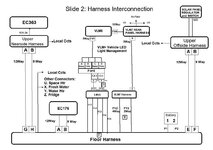Hi All,
This is my first post on this forum so please bear with me.
I am trying to understand the electrics on my two week old Auto-Trail F60. I have contacted Sargent who have failed to reply or even acknowledge my questions. Their support/manuals website seems to have stopped being updated in 2016.
Does anyone have any detail on the innards of the EC176 and EC363?
The F60 is also fitted with a 100W solar panel with battery switch. I would like to understand in more detail what I have bought.
In mitigation: I am used to the marine 12V environment where knowing and maintaining your electrics well is pretty essential for safety reasons (e.g. engine starting, nav lights and emergency radio comms). The lack of circuit diagrams (or, at the least, block diagrams) is leaving me feeling pretty exposed. I have a degree in electrical engineering which probably causes me to have more questions than most.
Any guidance gratefully received.
Cheers
Bob
This is my first post on this forum so please bear with me.
I am trying to understand the electrics on my two week old Auto-Trail F60. I have contacted Sargent who have failed to reply or even acknowledge my questions. Their support/manuals website seems to have stopped being updated in 2016.
Does anyone have any detail on the innards of the EC176 and EC363?
The F60 is also fitted with a 100W solar panel with battery switch. I would like to understand in more detail what I have bought.
In mitigation: I am used to the marine 12V environment where knowing and maintaining your electrics well is pretty essential for safety reasons (e.g. engine starting, nav lights and emergency radio comms). The lack of circuit diagrams (or, at the least, block diagrams) is leaving me feeling pretty exposed. I have a degree in electrical engineering which probably causes me to have more questions than most.
Any guidance gratefully received.
Cheers
Bob




